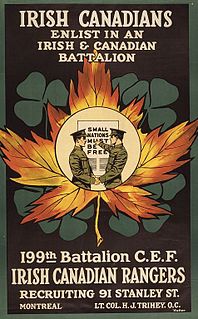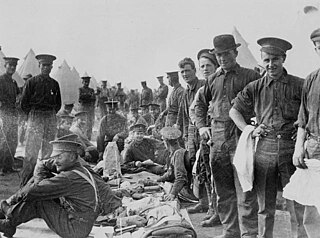
Les Voltigeurs de Québec is a Primary Reserve infantry regiment of the Canadian Forces. The name of the regiment commemorates another older French-speaking Canadian militia light infantry unit, the Canadian Voltigeurs. The founder of the Canadian Voltigeurs, lieutenant-colonel Charles-Michel d'Irumberry de Salaberry, was the father of the two men who raised Les Voltigeurs de Québec. The regiment was formed in March 1862, with its headquarters in Quebec City, by the amalgamation into a regiment of eight independent Volunteer Militia Rifle companies. The first of these companies was originally raised in December 1861. Between 1862 and 1867 these companies were frequently disbanded, reformed and renumbered. In 1942 it provided an armoured regiment.

Le Régiment de Maisonneuve is a Primary Reserve infantry regiment of the Canadian Forces. The regiment is Canada's twenty-sixth most senior reserve infantry regiment, and comprises one battalion serving as part of the Canadian Army Reserves.
The 171st Battalion, CEF was a unit in the Canadian Expeditionary Force during the First World War. Based in Quebec City, Quebec, the unit began recruiting during the winter of 1915/16. After sailing to England in November 1916, the battalion was absorbed by the 148th Battalion, CEF, 5th Pioneers, and the 20th Reserve Battalion in December 1916. The 171st Battalion, CEF had one Officer Commanding: Lieut-Col. Sir Wm. Price.
The 206th (Canadien-Francais) Battalion, CEF was a unit in the Canadian Expeditionary Force during the First World War.
The 117th Battalion, CEF was a unit in the Canadian Expeditionary Force during the First World War. Based in Sherbrooke, Quebec, the unit began recruiting in late 1915 through the eastern counties of Quebec. After sailing to England in August 1916, the battalion was absorbed into the 23rd Reserve Battalion on January 8, 1917. Through the 23rd Battalion it is linked to The Royal Montreal Regiment.
The 136th (Durham) Battalion, CEF was a unit in the Canadian Expeditionary Force during the First World War. Based in Kingston, Ontario, the unit began recruiting in late 1915 in Durham County, Ontario and Pontiac County, Quebec. After sailing to England in October 1916, the battalion was absorbed into the 39th Battalion, CEF and 6th Reserve Battalion on October 6, 1916. The 136th (Durham) Battalion, CEF had one Officer Commanding: Lieut-Col. R. W. Smart.

The 148th Battalion, CEF was a unit in the Canadian Expeditionary Force during the First World War. Based in Montreal, Quebec, the unit began recruiting in late 1915 in that city and the surrounding district. After sailing to England in September 1916, the battalion was absorbed into the 20th Reserve Battalion on January 8, 1917. The 148th Battalion, CEF had one Officer Commanding: Lieut-Col. A. A. Magee.
The 150th Battalion, CEF was a unit in the Canadian Expeditionary Force during the First World War. Based in Montreal, Quebec, the unit began recruiting in late 1915 in that city and the surrounding district. After sailing to England in September 1916, the battalion was absorbed into the 14th, 22nd, 24th, and 87th Battalions, CEF, and the 5th Canadian Mounted Rifles. The unit officially ceased to exist as of February 15, 1918. The 150th Battalion, CEF had one Officer Commanding: Lieut-Col. Hercule Barre.
The 163rd (Canadien-Francais) Battalion, CEF was a unit in the Canadian Expeditionary Force during the First World War. Based in Montreal, Quebec, the unit began recruiting in late 1915 throughout the province of Quebec. In May 1916, the battalion sailed for Bermuda, where it remained on garrison duty until late November of the same year. After arriving in England, the battalion was absorbed into the 10th Reserve Battalion on January 8, 1917. The 163rd (Canadien-Francais) Battalion, CEF had one Officer Commanding: Lieut-Col. H. DesRosiers.

The 199th Battalion, CEF was a unit in the Canadian Expeditionary Force during the First World War.
The 230th Battalion, CEF was a unit in the Canadian Expeditionary Force during the First World War. Based in Ottawa, Ontario, the unit began recruiting in early 1916 in eastern Ontario, Hull, Quebec, and the surrounding district. The battalion also drew heavily from members of the 70th Regiment, based in Hull, Quebec. The battalion became the 230th Forestry Battalion in October 1916. This unit apparently sent six drafts overseas in 1917; these were on January 23 (SS Scandinavia), January 26 (SS Grampian), March 3 (SS Ausonia), May 3 (SS Justicia), June 2 (SS Olympic), and June 25.
The 244th Battalion, CEF was a unit in the Canadian Expeditionary Force during the First World War. Based in Montreal, Quebec, the unit began recruiting in the spring of 1916 in Montreal and the surrounding district. After sailing to England in April 1917, the battalion was absorbed into the 23rd Reserve Battalion, CEF later that month. The 244th Battalion, CEF had one Officer Commanding: Lieut-Col. E. M. McRobie.
The 245th Battalion, CEF was a unit in the Canadian Expeditionary Force during the First World War. Based in Montreal, Quebec, the unit began recruiting in the spring of 1916 in that city. After sailing to England in May 1917, the battalion was absorbed into the 23rd Reserve Battalion, CEF upon arrival. The 245th Battalion, CEF had one Officer Commanding: Lieut-Col. C. C. Ballantyne.

The 5th Battalion Canadian Mounted Rifles were a mounted infantry unit of the Canadian Expeditionary Force (CEF) during World War I. The unit was raised from volunteers of the 7th and XIth (Canadian) Hussars from the Eastern Townships of Quebec.
The 69th Battalion (Canadien-Français), CEF was an infantry battalion of the Canadian Expeditionary Force during the Great War. The 69th Battalion was authorized on 10 July 1915 and embarked for Britain on 17 April 1916. The battalion provided reinforcements to the Canadian Corps in the field until 4 January 1917, when its personnel were absorbed by the 10th Reserve Battalion, CEF. The battalion was disbanded on 30 August 1920.

The Royal Rifles of Canada was a rifle regiment in the Canadian Army and fought alongside The Winnipeg Grenadiers in the Battle of Hong Kong during World War II.

The 11th Battalion, CEF, an infantry battalion of the Canadian Expeditionary Force, was authorized on 10 August 1914 and embarked for Great Britain on 30 September 1914. It was redesignated as the 11th Reserve Infantry Battalion, CEF, on 29 April 1915, to provide reinforcements to the Canadian Corps in the field. On 4 January 1917, its personnel, along with the personnel of the 100th Battalion, CEF, were absorbed by a new 11th Reserve Battalion, CEF. The battalion was disbanded on 12 October 1917.
The 57th Battalion (Canadien-Français), CEF was an infantry battalion of the Canadian Expeditionary Force during the Great War. The 57th Battalion was authorized on 20 April 1915 and embarked for Britain on 2 June 1916. On 8 June 1916, its personnel were absorbed by the 69th Battalion, CEF to provide reinforcements to the Canadian Corps in the field. The battalion was disbanded on 11 April 1918.
The 59th Battalion (Ontario), CEF was an infantry battalion of the Canadian Expeditionary Force during the Great War. The 59th Battalion was authorized on 20 April 1915 and embarked for Britain on 1 April 1916. It provided reinforcements for the Canadian Corps in the field until 6 July 1916, when its personnel were absorbed by the 39th Battalion, CEF. The battalion was disbanded on 21 May 1917. The 59th Battalion recruited in Eastern Ontario and Hull, Quebec and was mobilized at Barriefield, Ontario.
The 15th Battalion, CEF was an infantry battalion of the Canadian Expeditionary Force during the Great War. The 15th Battalion was authorized on 1 September 1914, embarked for Britain on 26 September 1914 and arrived in France on 15 February 1915. The battalion fought as part of the 3rd Infantry Brigade, 1st Canadian Division in France and Flanders throughout the war. The battalion was disbanded on 30 August 1920.
Meek, John F. Over the Top! The Canadian Infantry in the First World War. Orangeville, Ont.: The Author, 1971.









